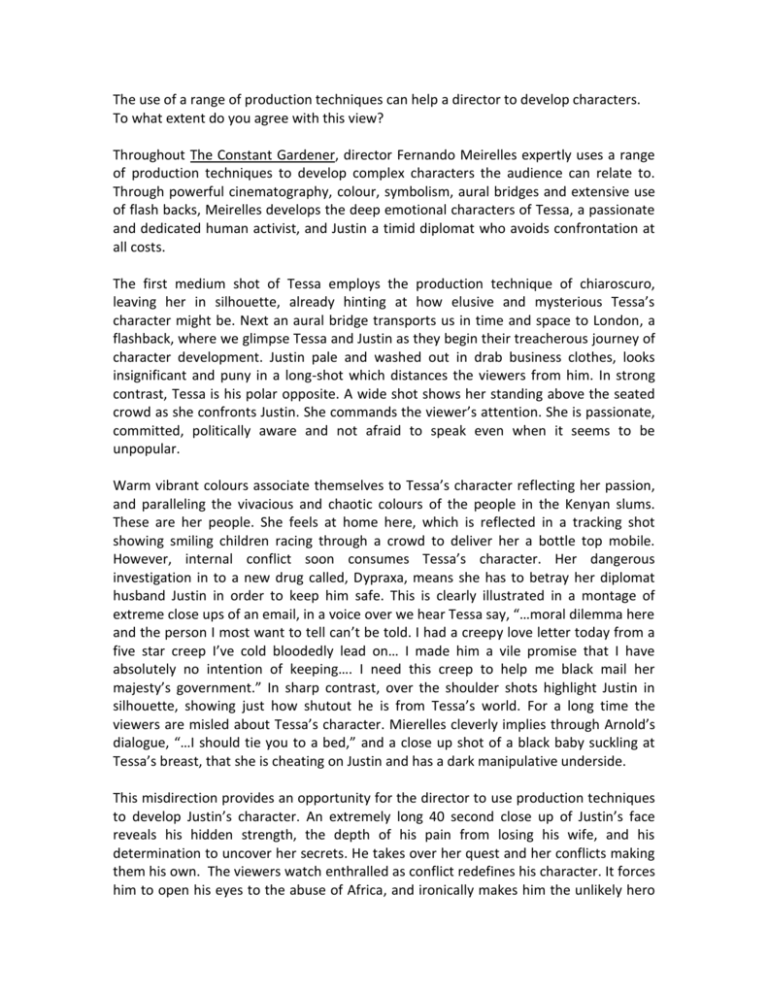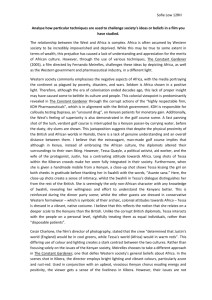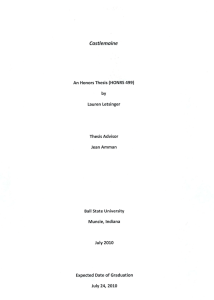The use of a range of production techniques can help a
advertisement

The use of a range of production techniques can help a director to develop characters. To what extent do you agree with this view? Throughout The Constant Gardener, director Fernando Meirelles expertly uses a range of production techniques to develop complex characters the audience can relate to. Through powerful cinematography, colour, symbolism, aural bridges and extensive use of flash backs, Meirelles develops the deep emotional characters of Tessa, a passionate and dedicated human activist, and Justin a timid diplomat who avoids confrontation at all costs. The first medium shot of Tessa employs the production technique of chiaroscuro, leaving her in silhouette, already hinting at how elusive and mysterious Tessa’s character might be. Next an aural bridge transports us in time and space to London, a flashback, where we glimpse Tessa and Justin as they begin their treacherous journey of character development. Justin pale and washed out in drab business clothes, looks insignificant and puny in a long-shot which distances the viewers from him. In strong contrast, Tessa is his polar opposite. A wide shot shows her standing above the seated crowd as she confronts Justin. She commands the viewer’s attention. She is passionate, committed, politically aware and not afraid to speak even when it seems to be unpopular. Warm vibrant colours associate themselves to Tessa’s character reflecting her passion, and paralleling the vivacious and chaotic colours of the people in the Kenyan slums. These are her people. She feels at home here, which is reflected in a tracking shot showing smiling children racing through a crowd to deliver her a bottle top mobile. However, internal conflict soon consumes Tessa’s character. Her dangerous investigation in to a new drug called, Dypraxa, means she has to betray her diplomat husband Justin in order to keep him safe. This is clearly illustrated in a montage of extreme close ups of an email, in a voice over we hear Tessa say, “…moral dilemma here and the person I most want to tell can’t be told. I had a creepy love letter today from a five star creep I’ve cold bloodedly lead on… I made him a vile promise that I have absolutely no intention of keeping…. I need this creep to help me black mail her majesty’s government.” In sharp contrast, over the shoulder shots highlight Justin in silhouette, showing just how shutout he is from Tessa’s world. For a long time the viewers are misled about Tessa’s character. Mierelles cleverly implies through Arnold’s dialogue, “…I should tie you to a bed,” and a close up shot of a black baby suckling at Tessa’s breast, that she is cheating on Justin and has a dark manipulative underside. This misdirection provides an opportunity for the director to use production techniques to develop Justin’s character. An extremely long 40 second close up of Justin’s face reveals his hidden strength, the depth of his pain from losing his wife, and his determination to uncover her secrets. He takes over her quest and her conflicts making them his own. The viewers watch enthralled as conflict redefines his character. It forces him to open his eyes to the abuse of Africa, and ironically makes him the unlikely hero of this film, whilst redefining his love for Tessa into something deeper. This is emphasized through the extensive use of flashbacks of their early relationship filled with warm lighting, smiles and the sound of laughter. Often Justin’s body language seemed blank and distant but these flashbacks give Justin’s character depth, allowing the audience to relate to him. Although Pellegrin, an important yet corrupt government official, only appears in a few scenes, powerful use of production techniques leaves a distinct impression of how dangerous this man is. He is a symbol of everything Justin could have become had he not been enlightened, and a reminder of everything Tessa was fighting against. A grey blue filter casts a harsh and menacing light onto the imposing and pretentious buildings of the British High Commission. All the elements in the setting, from the enormous spiral staircase to the crystal hung chandeliers and bronze pointing statues, are intimidating and highlight just how powerless Justin now is, a single soul against the British government. In a small German hotel room, incongruously cheerful and unsettling music plays as Justin is severely brutalized by KDH thugs. An extreme close up of his face lying in a pool of vomit, and yellow warning cards illustrate the seriousness of Justin’s situation. The closing high angled, long shot highlights Justin, tiny and helpless awaiting his death in the inhospitable environment of an African salt lake. This conveys exactly how powerless one man is against powerful and corrupt governments of both Africa and the western world. Justin’s character undertook an extreme transformation from a timid, polite and weak diplomat to a strong, brave and commanding personality. Ultimately he sacrifices his own life in order to complete his wife’s mission and reveal the abuse of Africa to the world. A complex range of production techniques from powerful cinematography, symbolism, colour, aural bridges and flash backs play an integral part in developing the complicated characters of Justin and Tessa in ‘The Constant Gardener.’ Meirelles takes the viewers on a journey through Africa as they observe the transformations in the two main characters as they struggle and ultimately give their lives to reveal the abuse of Africa.










